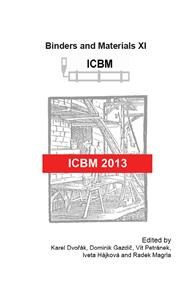[1]
S. Aydin, C. Karatay, B. Baradan, The effect of grinding process on mechanical properties and alkali-silica reaction resistance of fly ash incorporated cement mortars, Power technology 197, 2010, pp.68-72.
DOI: 10.1016/j.powtec.2009.08.020
Google Scholar
[2]
J. Payá, J. Monzó, M.V. Borrachero, E. Peris-Mora, Comparison among Magnetic and Non-magnetic Fly Ash Fractions: Strength Development of Cement-Fly Ash Mortars, Waste Management, Vol. 16, Nos 1-3, 1996, pp.119-124.
DOI: 10.1016/s0956-053x(96)00034-7
Google Scholar
[3]
N. Bouzoubaa, M.H. Zhang, A. Bilodeau, V.M. Malhotra, The Effect of Grinding on the Physical Properties of Fly Ashes and a Portland Cement Clinker, Cement and Concrete Research, Vol. 27, No. 12, 1997, pp.1861-1874.
DOI: 10.1016/s0008-8846(97)00194-4
Google Scholar
[4]
P. Chindaprasirt, S. Homwuttinwong, V. Sirivivatnanon, Influence of fly ash fineness on strength, drying shrinkage and sulfate resistance of blended cement mortar, Cement and Concrete Research, Vol 34, 2004, pp.1087-1092.
DOI: 10.1016/j.cemconres.2003.11.021
Google Scholar
[5]
B. Felekoglu, S. Türkel, H. Kalyoncu, Optimization of fineness to maximize the strength activity of high-calcium ground fly ash-Portland cement composites, Construction and Building Materials, Vol 23, 2009, p.2053-(2061).
DOI: 10.1016/j.conbuildmat.2008.08.024
Google Scholar
[6]
J. Payá, J. Monzó, M.V. Barrachero, E. Peris-Mora, F. Amahjour, Mechanical treatment of fly ashes Part IV: Strength development of ground fly ash-cement mortars cured at different temperatures, Cement and Concrete Research, Vol 30, 2000, pp.543-551.
DOI: 10.1016/s0008-8846(00)00218-0
Google Scholar
[7]
C. Jaturapitakkul, K. Kiattikomol, V. Sata, T. Leekeeratikul, Use of ground coarse fly ash as a replacement of condensed silica fume in producing high-strength concrete, Cement and Concrete Research, Vol34, 2004, pp.549-555.
DOI: 10.1016/s0008-8846(03)00150-9
Google Scholar
[8]
S. Tsivilis, S. Tsimas, A. Moutsatsou, Conctribution to the problems arising from the grinding of multicomponent cements, Cement and Concrete Research, Vol 22, 1991, pp.95-102.
DOI: 10.1016/0008-8846(92)90139-m
Google Scholar
[9]
J. Payá, J. Monzó, M.V. Barrachero, E. Peris-Mora, Mechanical treatment of fly ashes. Part I: Physico-chemical characterization of ground fly ashes, Cement and Concrete research, Vol. 25, No. 7, 1995, pp.1469-1479.
DOI: 10.1016/0008-8846(95)00141-x
Google Scholar
[10]
J. Payá, J. Monzó, M.V. Barrachero, E. Peris-Mora, Mechanical treatment of fly ashes. Part II: Particle morphologies in ground fly ashes(GFA) and workability of GFA-cement mortars, Cement and Concrete research, Vol. 26, No. 2, 1996, pp.225-235.
DOI: 10.1016/0008-8846(95)00212-x
Google Scholar
[11]
K. Kiattikomol, C. Jaturapitakkul, S. Songpiriyakij, S. Chutubtim, A study of ground coarse fly ashes with different finenesses from various sources as pozzolanic materials, Cement and Concrete Research, Vol. 23, 2001, pp.335-343.
DOI: 10.1016/s0958-9465(01)00016-6
Google Scholar
[12]
S.K. Antiohos, V.G. Papadakis, E. Chaniotakis, S. Tsimas, Improving the performance of ternary blended cements by mixing different types of fly ashes, Cement and Concrete Research, Vol 37, 2007, pp.877-885.
DOI: 10.1016/j.cemconres.2007.02.017
Google Scholar
[13]
K. Tan, X. Pu, Strengthening effect of finely ground fly ash, granulated blast furnace slag, and their combination, Cement and Concrete Research, Vol 28, No. 12, 1998, pp.1819-1825.
DOI: 10.1016/s0008-8846(98)00158-6
Google Scholar
[14]
J. Ryou, Improvement on reactivity of cementitious waste materials by mechanochemical activation, Materials letters 58, 2004, pp.903-906.
DOI: 10.1016/j.matlet.2003.07.047
Google Scholar
[15]
H. Sun, B. Hohl, Y. Cao, C. Handwerker, T.S. Rushing, T.K. Cummins, J. Weiss, JetMill Grinding of Portland Cement, Limestone, and Fly Ash: Impact on Particle Size, Hydration Rate, and Strength, Cement & Concrete Composites (2013).
DOI: 10.1016/j.cemconcomp.2013.03.023
Google Scholar
[16]
F. Blanco, M.P. Garcia, J. Ayala, G. Mayoral, M.A. Garcia, The effect of mechanically and chemically activated fly ashes on mortar properties, Fuel, Vol. 85, 2006, p.2018-(2026).
DOI: 10.1016/j.fuel.2006.03.031
Google Scholar
[17]
F. Blanco, M.P. Garcia, J. Ayala, Variation in fly ash properties with milling and acid leaching, Fuel, Vol. 84, 2005, pp.89-96.
DOI: 10.1016/j.fuel.2004.05.010
Google Scholar
[18]
S. Grzeszczyk, G. Lipowski, Effect of content and particle size distribution of high-calcium fly ash on the rheological properties of cement pastes, Cement and Concrete Research, Vol. 27, No. 6, 1997, P. 907-916.
DOI: 10.1016/s0008-8846(97)00073-2
Google Scholar
[19]
E. Peris Mora, J. Payá, J. Monzó, Influence if different sized fractions of a fly ash on workability of mortars, Cement and Concrete Research, Vol. 23, 1993, pp.917-924.
DOI: 10.1016/0008-8846(93)90045-b
Google Scholar


